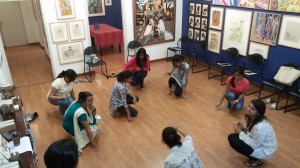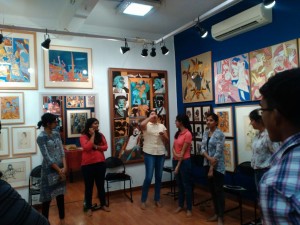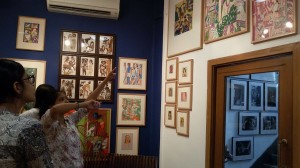‘The human race has been telling stories since it began’ – Doris Lessing
Everyone has a story of their own but not everyone can tell them. This is what sets storytellers apart from the rest. Storytelling is an art, which is to be expressed with the effect of impressing the listeners. A master storyteller should be able to engage his audience within the first five seconds of his speech otherwise he has lost his audience. Hence, at PeaceWorks volunteers meet, we focused on perfecting the art.
The session began with volunteers introducing themselves so that they were comfortable around each other. Paroma, our programme officer moderated the session. A round of warm-ups followed which helped the volunteers become comfortable with not only the space but also their bodies. Initially, they were asked to follow Paroma’s instructions but were too inhibited, with restricted movement. Discussing why this happened, and why it was important to work past these inhibitions in order to become effective storytellers, Paroma worked with the group until, very soon, they had become comfortable enough to really extend themselves, breaking down the barrier.
The second round of the session involved every individual selecting a painting at the Seagull Gallery space and developing a story of his or her own within a matter of a few minutes. Initially the volunteers started interpreting the painting—in a fairly straightforward manner. Paroma corrected them and made it clear that it has to be a story and not an interpretation. They finally got the hang of it and proceeded. One of the stories that stood out was based on an artwork of a girl sinking her face in her hands. Her story revolved around a girl who had been a victim of an acid attack and was simply too ashamed to look at the mirror. The volunteer even used the gallery lights to add character to her story. She continued by pointing at the light, likening it to the victim waiting for a ray of light or a path of hope in her life after such a catastrophe. This set a brilliant example of creativity, use of time, thinking outside the box and leaving a social message for her audience.
Then a circle was formed and the volunteers began to share some of their stories and activities that they would practice with their kids at the respective centers. They suggested that storytelling should not be limited to a unilateral conversation but the audience should have a fair chance of contribution. They pointed out activities like sketching the conclusion of the story or thinking of the social message on their own and voicing it. Paroma enacted part of the story, becoming a ribbiting frog one minute and a shy nightingale the next, demonstrating how the volunteers can engage with their audience.
A final activity, which can be called ‘passing the action/sound’, concluded the day. Each volunteer had to pass around the previous person’s action and sound and magnify it by emoting in a ‘larger’ way. Even though this activity was interrupted by giggles and guffaws at the failure of raising their voice higher than their predecessor, every volunteer managed to emote themselves through their body.
It definitely looked like the ‘inhibition syndrome’ had been cured.
– Shreyashee Roy
Intern



